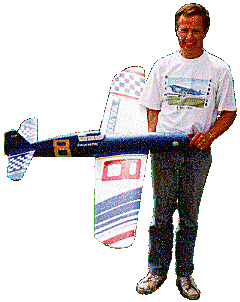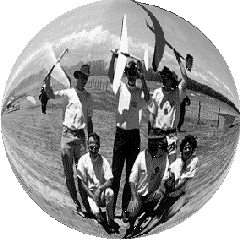


 |
  |
The FAI competition classes F3D and F5D define the rules for pylon racing events with model aircraft. Usually three to four aircraft are racing simultaneously around the race course, which is laid out by three pylons. Each model is supported by a team of two:
The helper is necessary, because the pilot is usually busy controlling the aircraft, and can not risk to have a look at the pylons or at his opponents planes.
 |
Layout and dimensions of the racing
course for F3D and F5D. The wind direction is from the single towards the
twin pylons. The start takes place 30 m from the twin pylons (against the wind of course). |
To avoid collisions during takeoff, the teams are started in one second intervals. To identify the competitors, each team is assigned a color. Located in safety cages near the single pylon and between the twin pylons, there is one judge for each team, who waves a flag of the color corresponding to the assigned team, when the model is passing the pylon. He also raises a colored plate, whenever the pylon has been cut, i.e. the pilot turned too early. For each cut, a penalty of 10 % is added to the time.
The racing distance for both classes is 10 laps, which amounts to a distance of more than 4000 m (F3D) or 3000 m (F5D). Today it takes less than 65 seconds to cover this distance with an F3D model. The top F5D aces perform their ten laps in about 80 seconds. For safety reasons, pilots and all callers wear helmets to protect them, but with experienced teams and good material, accidents are quite rare today.
Several facts are important for s successful pylon racing team:
 |
One of those fabulous men and his pretty ... nah,
not woman ... flying machine (It´s a Caudron C.460 from 1936 avec son pilot,
both from France, as seen in Italy by a German pilot) - note the pilots
matching T-shirt, although labeled »Club 20«! - Photo of Guy Broquieres, taken in Milano by Otto Jakob - |
The models for the F3D class are equipped with tuned 6,5 cm³ (.40 cu. inch) engines, which turn a typical carbon fiber propeller at speeds of more than 25000 rotations per minute. These engines run on standard fuel, without any additives like Nitromethan! Their power of about 3 kW results in model top speeds of more than 300 km/h. The top aces perform the 10 laps in less that 70 seconds, resulting in average speeds of 200 km/h and above.
 |
Airfoils for Piston Engine Powered Models |
In 1984, Professor Richard Eppler, well known for many airfoil designs for model aircraft, was approached by members of the Akamodell Stuttgart. They were not satisfied with the airfoils which were used at that time: airfoils like the symmetrical members of the NACA 64-series were not the perfect solution for an aircraft which would usually fly at positive lift coefficients only. On the other hand, the symmetrical sections had the advantage of having nil moment coefficient, which made it possible to use very small, low drag horizontal tailplanes.
Professor Eppler was asked to develop a series of airfoils which were adapted to the lift coefficient range while keeping the zero moment coefficient cm c/4 [5]. The result were the now legendary airfoils E 220 and E 221, which were used successfully during the next years.
Later, in 1986, when the construction methods had been greatly improved by the use of glass and carbon fiber reinforced plastic wings, built completely in moulds, it became time to think about further improvements. The logical development lead to a further extension of the area of laminar flow, which reduced the drag coefficient. A member of the Akamodell, Martin Hepperle developed a new set of airfoils, taking the velocity distributions of the Eppler sections as a starting point.
At the same time improvements were made in the area of propellers and in the reduction of the induced drag, which is important during the turns.
About 5 years later, when composite construction methods had become a quasi standard in high performance pylon models, a new set of airfoils (MH 23 to MH 27) was developed. These airfoils pushed the extent of laminar flow to the limit, leading to a quite abrupt pressure recovery region. Applied on perfectly molded wings, the results were very good, provided transition was occurring in front of the point of possible laminar separation (usually forced by a turbulator). During the design, the position of the transition strip was also varied to find to optimum location for minimum overall drag.
All these airfoils had been designed with Eppler's inverse mapping method - analysis had been performed with Epplers analysis module as well as Drelas Xfoil code.
The latest improvements in 2003 were starting with these MH 2x airfoils and state of the art numerical optimization tools were applied. It became clear, that it was not possible to reduce the minimum drag noticeably, but it was possible to improve width and shape of the laminar bucket. The resulting airfoils are the MH 16 and MH 17 for Q500 models. For F3D and Q-40 the MH 28
| Standard Airfoils | ||
| Q 500 | ||
| F3D | ||
| High Performance Airfoils (advanced construction methods recommended) | ||
| Q 500 |
|
|
| F3D Q-40 Reno |
||
| F3D Speed |
These airfoils are suited for high speed pylon racing and pure speed models. These models typically achieve speeds over 300 km/h. | |
 |
Airfoils for Electric Powered Models |
When the electrically powered models got mature in the 1990s, some enthusiasts started to develop pylon racing models. Today the FAI class F5D is defining the rules for these pylon racing models. The models are much smaller than the combustion engine driven F3D models, have a rather high wing loading which makes some of the models a little bit difficult to handle during the start. In contrast to the F3D class, no takeoff from the ground is performed, instead the models are hand launched (see: a typical F5D model).
 |
The German F5D team in the hot sun of Wangaratta, Australia (1995). For more information see: |
Background shows Tsunami , a full scale pylon racing aircraft, flown in the unlimited class at Reno air races
Last modification of this page: 21.05.18
![]()
[Back to Home Page] Suggestions? Corrections? Remarks? e-mail: Martin Hepperle.
Due to the increasing amount of SPAM mail, I have to change this e-Mail address regularly. You will always find the latest version in the footer of all my pages.
It might take some time until you receive an answer
and in some cases you may even receive no answer at all. I apologize for this, but
my spare time is limited. If you have not lost patience, you might want to send
me a copy of your e-mail after a month or so.
This is a privately owned, non-profit page of purely educational purpose.
Any statements may be incorrect and unsuitable for practical usage. I cannot take
any responsibility for actions you perform based on data, assumptions, calculations
etc. taken from this web page.
© 1996-2018 Martin Hepperle
You may use the data given in this document for your personal use. If you use this
document for a publication, you have to cite the source. A publication of a recompilation
of the given material is not allowed, if the resulting product is sold for more
than the production costs.
This document may accidentally refer to trade names and trademarks, which are owned by national or international companies, but which are unknown by me. Their rights are fully recognized and these companies are kindly asked to inform me if they do not wish their names to be used at all or to be used in a different way.
This document is part of a frame set and can be found by navigating from the entry point at the Web site http://www.MH-AeroTools.de/.